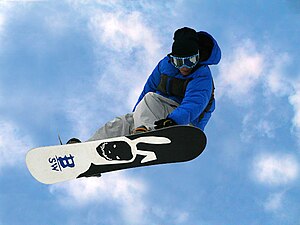 |
| English: freestyle snowboarding (Photo credit: Wikipedia) |
Last Updated: 2013-01-18 16:48:11 -0400 (Reuters Health)
NEW YORK (Reuters
Health) - Introducing snowboarders to the mix at one ski resort in New
Mexico led to a small increase in the overall number of injuries on the
mountain, according to a new study.
Though the results are only from one mountain, they're in line with patterns seen elsewhere, according to a researcher who studies snowboard and ski injuries, but was not involved in the new work.
"If you did that at 10 different mountains, the trend would be the same," said Dr. Robert Johnson, from the University of Vermont College of Medicine in Burlington.
The new study could not pinpoint why overall injury rates rose, but the authors, led by Dr. David Rust from the University of New Mexico in Albuquerque, found hints that several different factors were at play.
They looked at records from the Mogul Medical Clinic at Taos Ski Valley and compared the injuries that happened before and after snowboarding was first allowed in March 2008.
Overall, the rate of injuries increased from about 207 per 100,000 visits to the mountain in the 2006 to 2007 winter season, to about 234 injured per 100,000 in the 2009 to 2010 season.
That increase was mostly due to a rise in the kind of upper body injuries that are most common among snowboarders, such as wrist sprains and fractures.
For example, the researchers found, broken wrists jumped from the tenth most common injury before the snowboarders were allowed on the mountain to the second most common injury at the end of the study.
On the other hand, lower body injuries that are most typical among skiers, such as anterior cruciate ligament or ACL tears and knee sprains, remained constant.
During the study period, the number of visitors to the mountain also rose, from an average of 1,610 per day during the 2006 to 2007 season until March 2008, to 1,973 visits per day from March 2008 to the end of the 2009 to 2010 season.
The average age of injured people dropped meanwhile, from 39 years old without snowboarders to 31 with them.
The researchers were not able to say why the number of injuries increased, but previous research suggests snowboarders are more injury-prone than skiers.
Last year, Johnson and his colleagues found that snowboarders accounted for 19 percent of injuries at one ski mountain in Vermont, but only made up 17 percent of athletes on the slopes (see Reuters Health article of Feb 1, 2012 here: http://reut.rs/SWqvWS).
The new report avoids suggesting that snowboarding is the more dangerous sport, or that skiers are taking more risk by sharing the slopes.
"Instead, we recognize that a small but statistically significant increase in injury rate was observed after the addition of snowboarding to this mountain but that factors other than type of sport may play a role in the differences that were identified," Rust and his colleagues write.
Some of those factors include snowboarding having brought in a younger group of people who tend to take more risks as well as raising the overall number of people on the slopes, according to the researchers.
They conclude that winter resorts can use their findings to institute more safety precautions - such as widening slopes, better training medical providers and promoting the use of wrist guards and helmets - to try to curtail a rise in injuries when snowboarders come on the scene.
SOURCE: http://bit.ly/UTiFZG The American Journal of Sports Medicine, online January 16, 2013.
Copyright © 2013 Reuters Limited. All rights reserved.
Republication or redistribution of Reuters content, including by framing or
similar means, is expressly prohibited without the prior written consent of
Reuters.






No comments:
Post a Comment